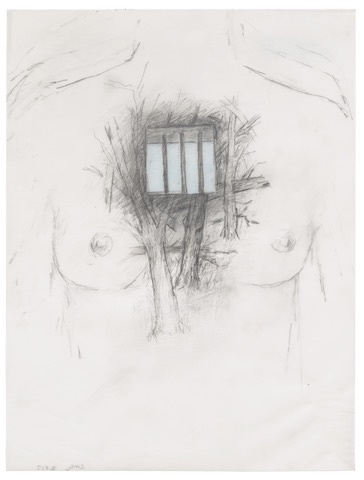That Robert Gober opens this exhibition with a drawing made in 1967, when he was just thirteen years old, suggests that past and present will share its stage. On a page torn roughly from a spiral-bound notebook, Icarus is shown gliding blissfully towards the sun and also plunging into the sea, his legs poking out from a splash in the same corner of the composition that claims Bruegel’s shortlived aviator. Discrete moments in time are, here and everywhere in Gober’s work, collapsed into a single frame.
If his drawings and sculptures are to measure time – as Gober’s exhibition title promises – then Icarus (1967) implies a nonlinear version of it. All of the composite parts exist simultaneously, a flat plane marked by fixed points between which it is possible to draw patterns, in this case the line connecting the drawing’s three elements: a burning sun resembling the monstrance that carries the Host during Eucharist, Icarus ascendant and Icarus fallen. This is a work of art that functions like the memory of someone’s life after their death, their tragedies bound up with their triumphs.
The possibility – or, in Icarus’s case, impossibility – of escape from imprisonment is alluded to by the dollhouse-size, balsa wood Maquette for cellar door (2001) that extrudes from the opposite wall and then, in the gallery’s second room, by a series of 14 pencil and pastel drawings. Each depicts a smudged torso cropped at the neck and hips, and covered, as if lightly tattooed, by a forest of crisscrossed bare trees. Over the heart is a barred window through which a clear blue sky is visible. As with the sink, drain and urinal sculptures for which Gober is best known, the works imagine holes in bodies through which something might move.
The reversed signature at the bottom left of each drawing offers a clue as to what that something might, in this case, be. The viewer is looking at the verso of images executed on tracing paper, and so it is her gaze that moves through the figures and, by extension, towards the artist on the other side of the sheet. If the artist is absent, or perceptible only as a bright light in the sky, then a replica of the missing heart can be found in a shallow box frame, backed by a scrap of wallpaper patterned with budding leaves (Plaster Heart on Fabric, 1988–2017). This is one of 16 assemblages that, like more tender Joseph Cornell boxes, repurpose Gober’s studio leftovers as works of art. They operate according to a metaphoric logic evoking birth and death in its symbols – dead leaves, broken eggshells and Edenic apples are combined with more domestic signifiers like crushed cigarette packets and soiled diapers – and its ineffability. These trapped and frozen relics of a life, reminiscent of the shrines that line the streets of Southern Italian cities, are mysteries on which to dwell rather than puzzles to be decoded.
The prospect of escaping the lifetime described by this exhibition is raised by the sculpture (Untitled, 2000–2001) that concludes it. A lifesize trapdoor leads down a set of steps to a distressed cellar door, below the gallery’s floor level, through the cracks in which light leaks out. The sculpture calls to mind the distressed wooden gates of Marcel Duchamp’s Étant Donnés (1946–66), but where that work offers a peephole through which the viewer can peer into an intricately coded dreamworld on the other side, this door offers no such possibility of revelation. What lies beyond remains obscure, and the portents are contradictory: the warm light carries the promise of redemption, while the prospect of being trapped underground is frightening. This sense of being at the same time drawn to, and repelled by, a combination of signs lends the work its uncanny power.
The cellar door is typical of Gober’s ability seamlessly to interweave personal narratives – the door is modelled on one built by the artist’s father in his childhood home – with art-historical allusion. The effect is to create works that are at once familiar, in their play with the strategies of surrealism and the forms of minimalism, and inscrutable, in the significance of certain signifiers to the artist’s own lived experience. In this respect, the work might also function as a metonym for Tick Tock, which invites the visitor into the artist’s life without offering a way out. Placed in the final room of Matthew Marks’s narrow gallery, against the wall furthest from the entrance, the cellar door reads like an exit. But it is locked, and so the visitor is forced to loop back from the exhibition’s end to its start, reappraising the latter in light of the former.
Robert Gober: Tick Tock at Matthew Marks Gallery, New York, 23 February – 21 April
From the May 2018 issue of ArtReview
